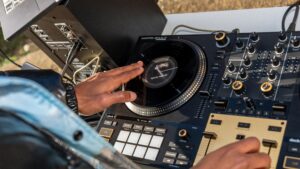29.04.2024
So you want to learn how to scratch?
Scratching is an art form that has become synonymous with the culture of hip-hop and electronic music. It’s a skill that adds flair, rhythm, and personality to DJ performances, captivating audiences and energizing dance floors. While scratching may seem daunting to beginners, mastering the basics can be an incredibly rewarding journey. In this guide, we’ll explore some beginner techniques to help you kickstart your scratching skills and unleash your creativity behind the decks.

Understanding the basics
Before diving into scratching techniques, it’s essential to understand the fundamentals. Scratching involves manipulating vinyl records or digital audio files on a turntable using a DJ mixer and a stylus or DJ controller. The basic components include the sound source (record or digital file), the turntable, the mixer, and the DJ’s hands. If you got your hands on the DJControl Inpulse T7 Premium Edition, you’d be manipulating the digital audio via your preferred DJ software such as DJUCED or Serato DJ Lite.
To learn more about the basics of correct timing and the baby scratch, check out our DJ Academy tutorial on our YouTube channel by DJ LiftOFF:
Hand positioning
Proper hand positioning is crucial for effective scratching. The dominant hand controls the jog wheel, while the non-dominant hand adjusts the fader on the mixer. Keep your fingers relaxed and poised to execute precise movements.
Baby scratch
The baby scratch is the foundation of scratching techniques. To perform a baby scratch, place your hand on the record or jog wheel and move it back and forth in a rhythmic motion while simultaneously opening and closing the crossfader on the mixer. Start slowly to get comfortable with the motion, then gradually increase speed as you gain confidence.
Forward scratch
The forward scratch involves moving the record or jog wheel in a forward motion while keeping the crossfader open. This creates a smooth, continuous sound that adds texture to your mixes. Experiment with different speeds and lengths of the forward motion to create variations in sound.
Chirp scratch
The chirp scratch is a more advanced technique that requires precision and timing. To execute a chirp scratch, start with the crossfader closed and the record or jog wheel stationary. Quickly move the record forward while simultaneously opening and closing the crossfader in a single motion. The result is a crisp, staccato sound that adds dynamic rhythm to your mixes.
Transformer scratch
The transformer scratch is characterized by rapid, choppy movements of the record or jog wheel combined with quick openings and closures of the crossfader. This technique creates a distinctive “transformer” sound and is commonly used for creating energetic fills and transitions in DJ sets.
Flare scratch
The flare scratch is an advanced technique that involves intricate movements of both hands to create complex rhythmic patterns. To perform a flare scratch, alternate between opening and closing the crossfader while executing rapid forward and backward movements of the record or jog wheel. Practice precision and control to master this challenging technique.
To see the chirp, transformer and flare scratch in practice, check out our DJ Academy tutorial on our YouTube channel by DJ LiftOFF: https://www.youtube.com/watch?v=XM4nC6ITZ1Q
Practice, patience, and persistence
Like any skill, mastering DJ scratching techniques requires dedicated practice, patience, and persistence. Start by practicing basic scratches and gradually progress to more advanced techniques as you build confidence and proficiency. Set aside regular practice sessions to hone your skills and experiment with different scratching styles and rhythms.
Experimentation and creativity
Don’t be afraid to experiment and explore your creativity when scratching. Mix and match techniques, incorporate effects, and develop your unique style that reflects your personality and musical preferences. Embrace mistakes as learning opportunities and keep pushing the boundaries of your creativity.
Seeking inspiration and learning
Take inspiration from experienced DJs, watch tutorial videos, attend workshops, and connect with fellow DJs to learn new techniques, exchange ideas, and stay inspired on your scratching journey. Embrace a growth mindset and continually strive to improve and evolve as a DJ.
In conclusion, beginner DJ scratching techniques serve as the foundation for mastering the art of scratching and elevating your DJ performances to new heights. With dedication, practice, and a willingness to experiment, you can develop the skills and confidence to create electrifying mixes that captivate audiences and leave a lasting impression on the dance floor. So grab your T7, cue up your favorite tracks, and let the scratching begin!